Do you need a handy guide for identifying different types of birds in Michigan? Check out this list of common birds around the Great Lakes state, including red, blue, yellow, and black birds in the area. Also, find out the most familiar large birds and water birds in the state. Discover how to identify them, where to find them, what to listen for, and how to attract them to your backyard feeders.
Types of Blue Birds in Michigan
From sky blue to bright indigo, blue birds are abundant in Michigan. Find out if your feathered friend matches one of these descriptions!
Blue Jay
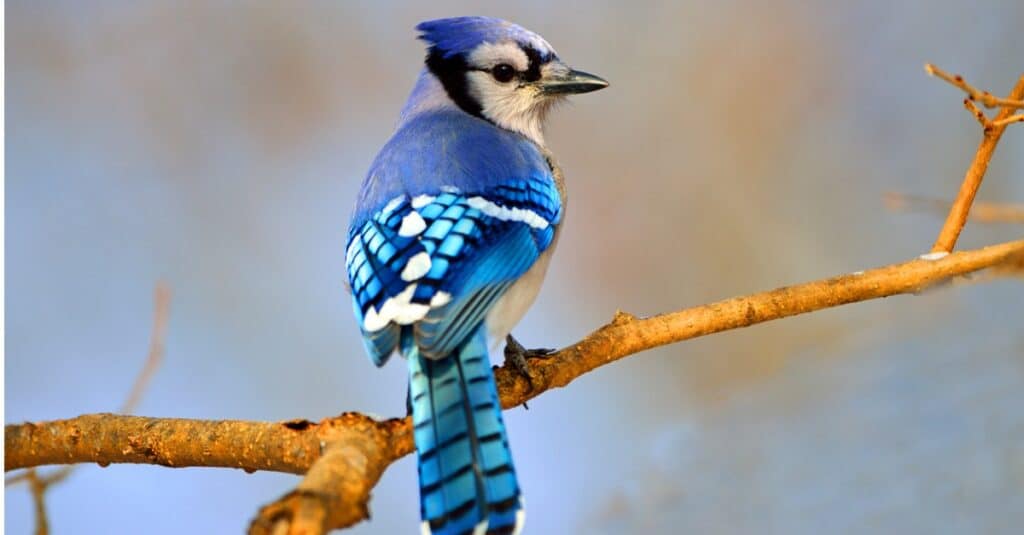
Beech and oak trees are the most common places where blue jays forage.
©iStock.com/BrianEKushner
Appearance: Large songbirds with shaggy crests. Adults are white to light gray underneath and a mixture of sky blue, medium blue, white, and black above. They also have white faces with black markings.
Location: They live year-round throughout Michigan, inhabiting forest edges and urban and suburban areas.
Calls: Extremely loud and raucous cries. But they also produce soft clicks, chucks, and whirs.
Backyard Tips: Place suet, peanuts, and sunflower seeds inside a tray feeder.
Barn Swallow
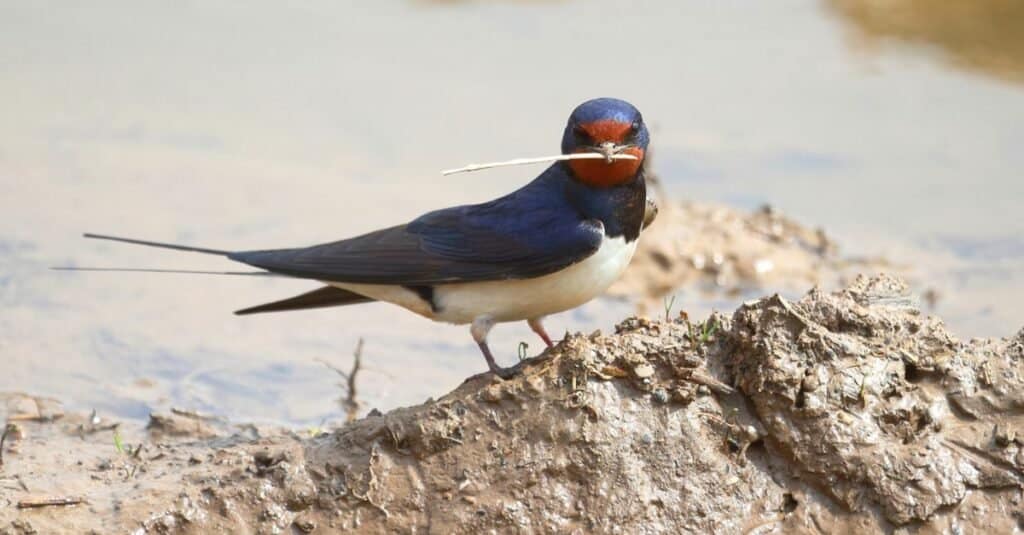
Barn swallows can be found throughout Michigan during spring and summer.
©PavlovaSvetlana/Shutterstock.com
Appearance: Bluish backs, wings, and tails, with tawny undersides and deep reddish-brown faces. Barn swallows also feature blue crowns, black bills, and white spots under their tails. Their head appears flattened with no neck, and their wings are long and pointed.
Location: You can find them throughout the state during spring and summer, where you can find them in parks, fields, beaches, and open water (lakes and ponds).
Calls: Constant twittering and mechanical whirs
Backyard Tips: Place ground-up eggshells in a platform feeder.
Indigo Bunting
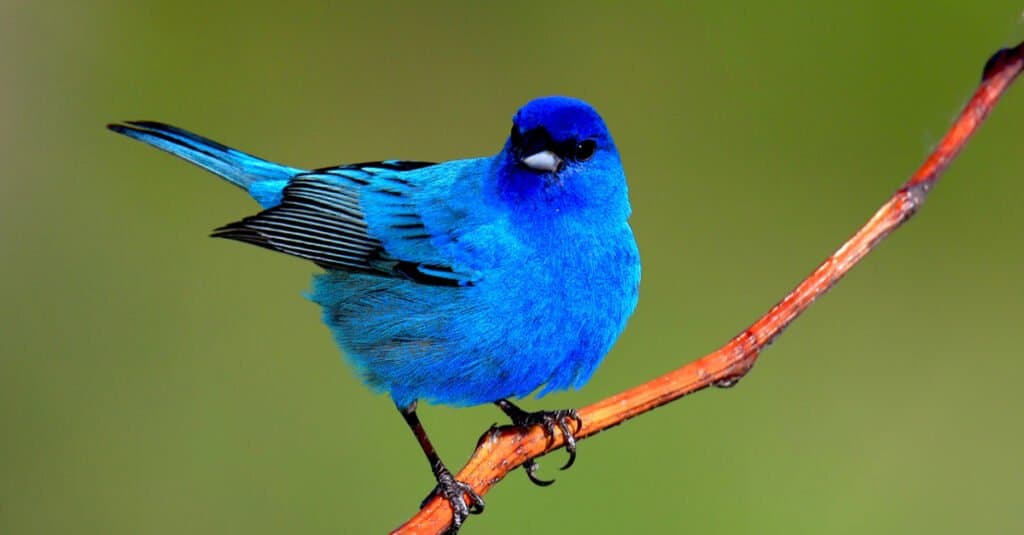
Indigo buntings breed throughout Michigan during spring and summer.
©John L. Absher/Shutterstock.com
Appearance: Small and stocky, the indigo bunting is about the size of a sparrow. The adult breeding male has a rich blue head, silver bill, and a light blue body. Females are brown with white throats and streaky breasts.
Location: They breed throughout Michigan during spring and summer. You can find them in bushy or weedy habitats, around wood edges, fields, and streams.
Calls: Clear, lively songs with high-pitched notes. Short, sharp chips.
Backyard Tips: Thistle, nyjer, and live mealworms work well to attract indigo buntings.
Eastern Bluebird
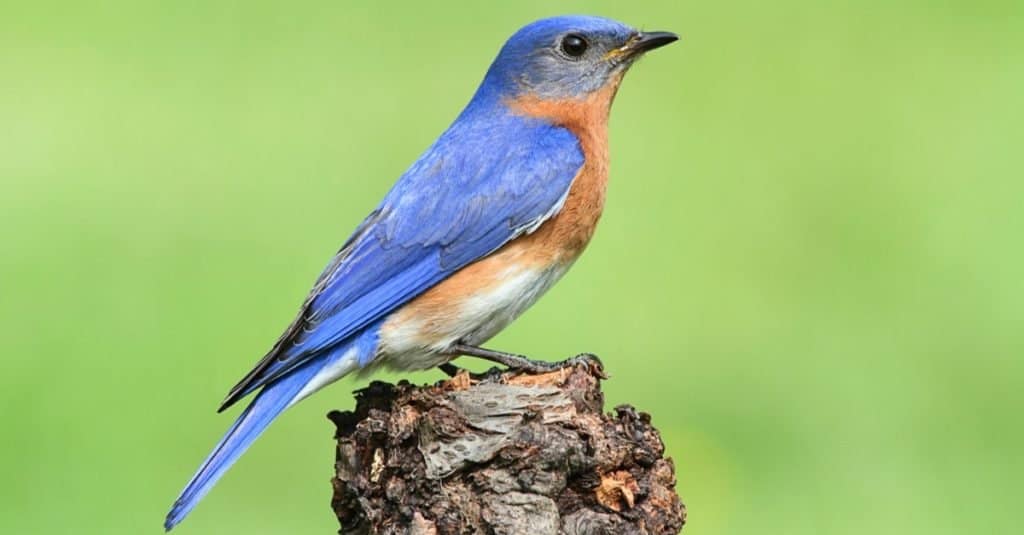
The eastern bluebird is a small, plump thrush with a big head and large eyes.
©Steve Byland/Shutterstock.com
Appearance: The eastern bluebird is a small, plump thrush with a big head and large eyes. Males are deep blue above and white below with reddish-brown breasts and throats. However, from a distance, they appear dull in color.
Location: They spend springs and summers all through Michigan, and you can find them in open countries, like pastures, agricultural fields, parks, and backyards.
Calls: Soft, low-pitched calls and hushed melodious warbles.
Backyard Tips: They will occasionally eat mealworms at feeders. You can also place a nesting box on your property.
Types of Black Birds in Michigan
Black is a common color in the bird world, but it doesn’t make these species any less special. Check out the four most familiar black birds in Michigan.
Brown-Headed Cowbird
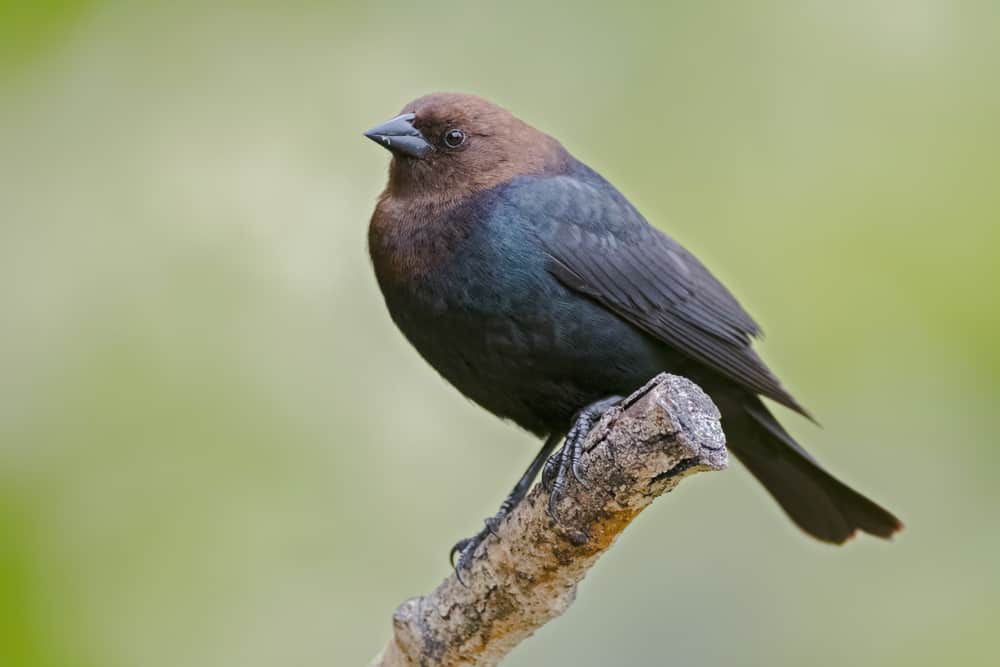
Brown-headed cowbirds breed in central and northern Michigan and live year-round in southern portions of the state.
©punkbirdr/Shutterstock.com
Appearance: Small black birds with stocky bodies, shiny black bodies with deep brown heads. Females are light brown with streaking on their bellies.
Location: They breed in central and northern Michigan and live year-round in southern portions of the state. Their preferred habitats include grassland, woodland edges, thickets, pastures, and the suburbs.
Calls: Squeaky gurgles, sliding whistles, clicking, and chattering.
Backyard Tips: Scatter grain on open ground to attract the brown-headed cowbird.
Red-Winged Blackbird
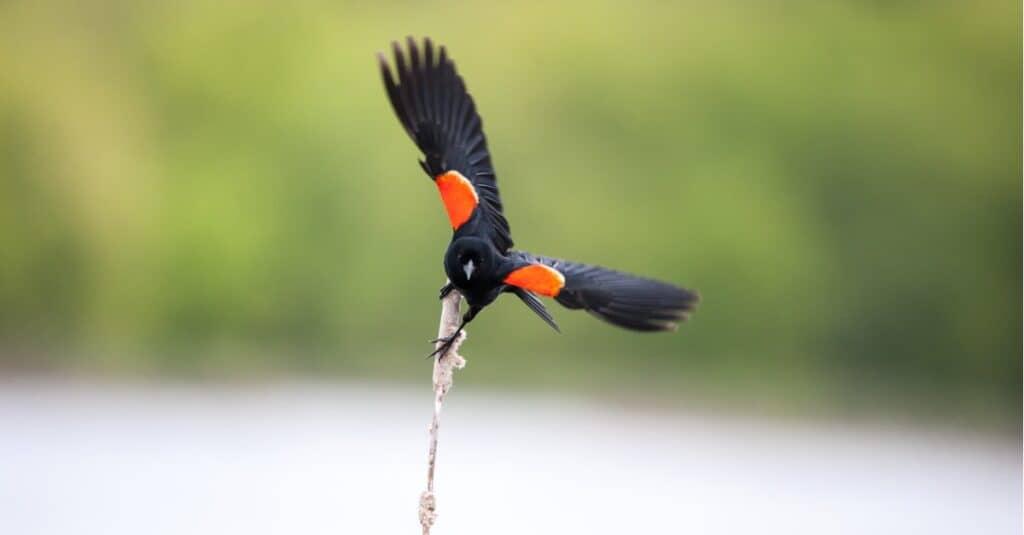
The shoulder feathers of red-winged blackbirds help them to be easily identified.
©iStock.com/maiakphotography
Appearance: A plump, broad-shouldered bird with all-black plumage and red and yellow shoulder patches. Females are dark brown and streaked.
Location: It breeds throughout Michigan in the spring and summer. You will find them in fresh or saltwater marshes and rice paddies.
Calls: Rich, musical songs and matter-of-fact calls (check).
Backyard Tips: Spread mixed grain and seeds on the ground.
European Starling
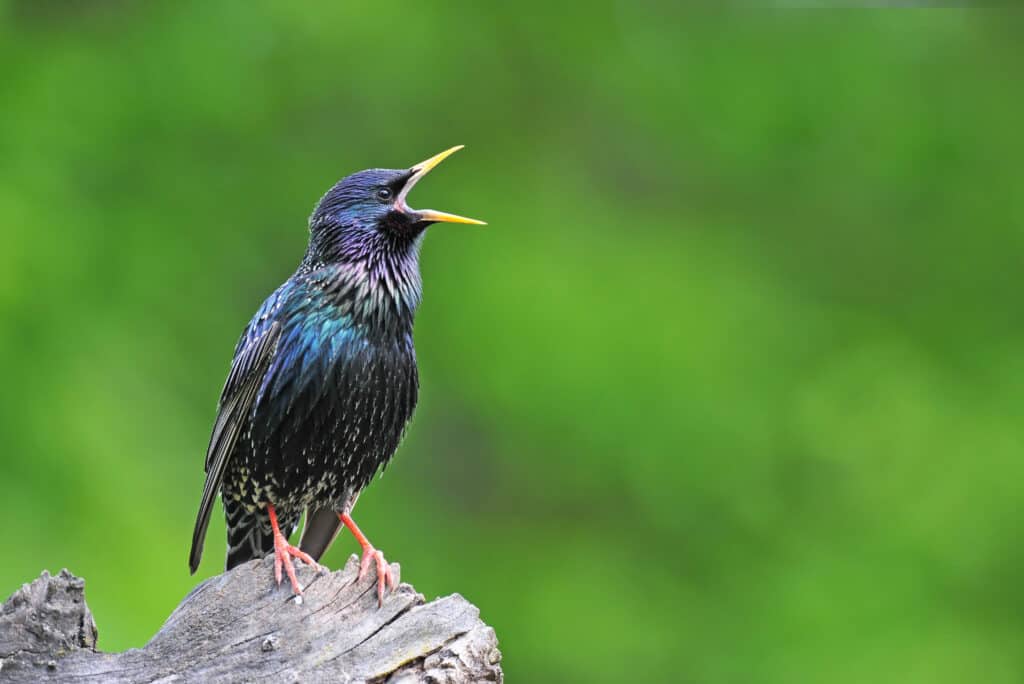
European starlings are excellent mimics and can imitate other birds, machinery, and even human speech.
©Soru Epotok/Shutterstock.com
Appearance: Chunky birds with long beaks. The European starling features black plumage with green and purple iridescence and yellow beaks. In winter, they appear brown with white spots.
Location: They live year-round in Michigan and are common around human habitations. Look for them on city streets, mowed lawns, and agricultural fields.
Calls: Squeaky, raspy musical notes and purr-like and rattle calls.
Backyard Tips: Provide a clean water supply and set out mealworms and suet.
Common Grackle

Common grackles are typically monogamous and form breeding pairs in the spring.
©Melinda Fawver/Shutterstock.com
Appearance: Large and lanky, common grackles are black with glossy purple heads and bronze bodies. They feature bright golden eyes. And females are similar but less glossy.
Location: This species breeds throughout most of Michigan and lives year-round in the far southern portions of the state. You can find them in open woodlands, grasslands, meadows, swamps, and human landscapes.
Calls: Clucks and high-pitched screeches
Backyard Tips: Place mixed grains and seeds on the ground and in feeders.
Types of Red Birds in Michigan
Red birds are unmistakable. They are visually striking, catching your eye faster than most other species. Learn about these four red-feathered friends in Michigan.
Northern Cardinal

Northern cardinals consume mostly seeds as part of their diet.
©Rob Palmer Photography/Shutterstock.com
Appearance: The northern cardinal has a long tail and a short, thick bill. Males are bright red all-over with black faces. Females are light brown with a red tinge around the wings and tails.
Location: This species lives year-round across Michigan. Look for them in backyards, overgrown fields, thickets, and forest edges.
Calls: Rich, repetitive whistles and metallic chips.
Backyard Tips: Place sunflower seeds in a feeder and leave undergrowth on your property for nesting.
American Robin
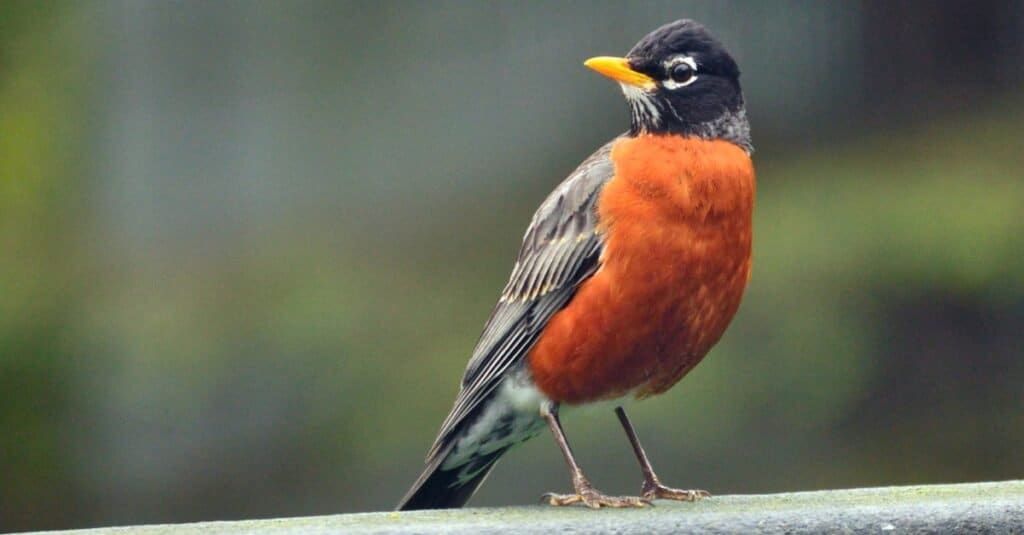
American robins feature long, round bodies and dark heads, grayish-brown streaky plumage above, and warm orange below.
©iStock.com/PhotosByMSA
Appearance: American robins feature long, round bodies and dark heads, grayish-brown streaky plumage above, and warm orange below. Witness the white patch on their bellies and underneath their tails as they fly.
Location: They live year-round in Michigan, and you can find them in backyards, parks, fields, woodlands, forests, and mountains.
Calls: Rich, caroling notes, and mumbled chucks.
Backyard Tips: Provide chunks of apples, strawberries, and other fruits.
Ruby-Throated Hummingbird
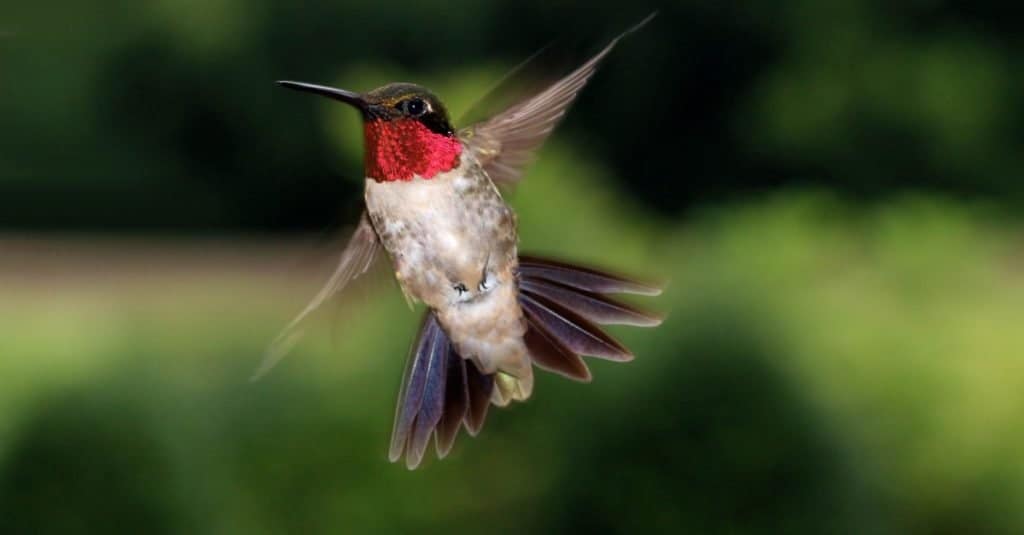
Ruby-throated hummingbirds feature distinctive ruby-red iridescent throats.
©Ramona Edwards/Shutterstock.com
Appearance: These tiny, slender birds feature bright emerald plumage on the crown and back, with grayish-white undersides. They also feature distinctive ruby-red iridescent throats.
Location: They breed throughout Michigan in deciduous woodlands, meadows, orchards, and backyards.
Calls: Twittering squeaks and monotonous chips.
Backyard Tips: Set up hummingbird feeders with sugar water and tubular plant flowers.
House Finch
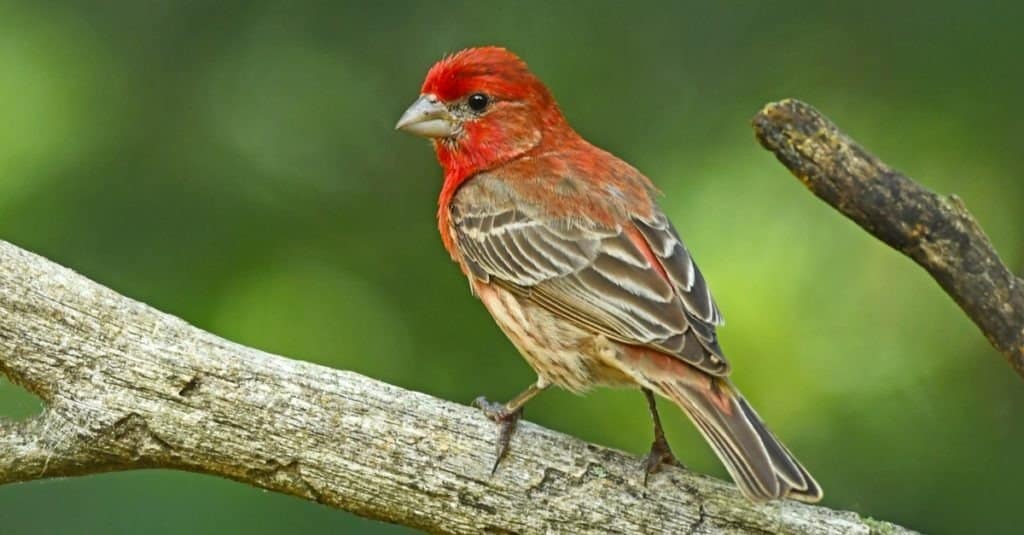
House finches have large beaks and flat heads.
©Brian A Wolf/Shutterstock.com
Appearance: These small finches have large beaks and flat heads. Males have rosy red faces and breasts, brown backs, and white bellies. Females are grayish-brown.
Location: They live year-round in the state and can find them around human habitations, including yards and buildings.
Calls: Chirp calls and extensive warbling notes
Backyard Tips: Fill your feeders with black oil sunflower seeds.
Types of Yellow Birds in Michigan
Bright yellow plumage is a reminder of spring. Check out these vibrant yellow birds in Michigan and find out where they live.
American Goldfinch
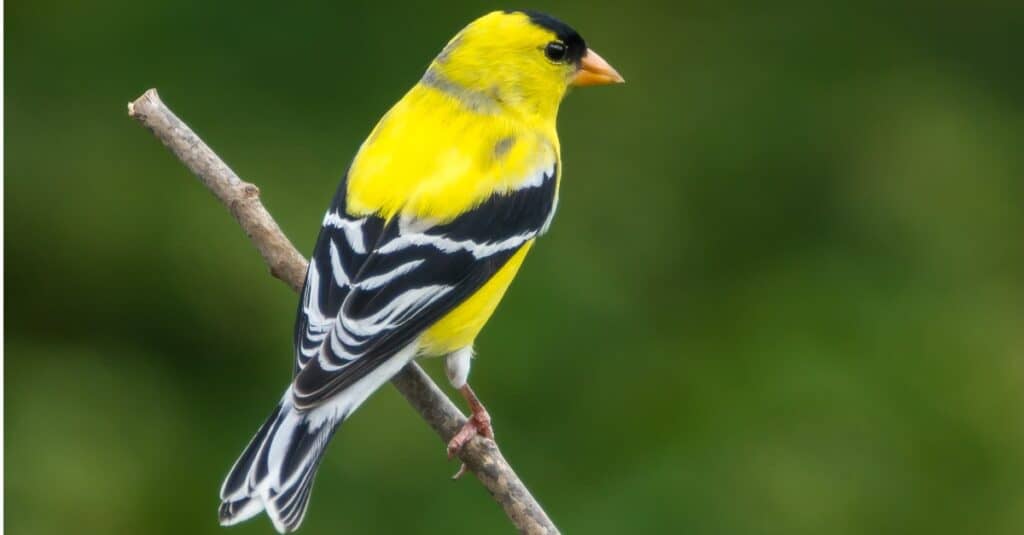
The American goldfinch averages around five inches in length.
©iStock.com/impr2003
Appearance: This compact bird symbolizes spring and summer, with a bright yellow body, black forehead, and black and white wings. Females are dull yellow below and olive above.
Location: They live year-round in Michigan and inhabit weedy fields, floodplains, suburbs, parks, and backyards.
Calls: Bright “potato chips” and long twitters.
Backyard Tips: Plant native thistle and milkweed.
Common Yellowthroat
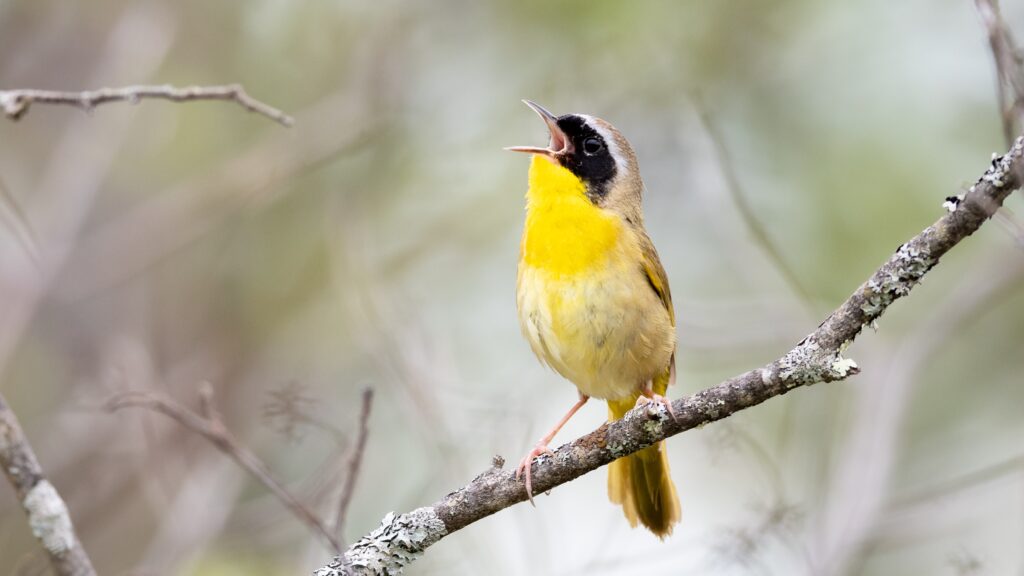
Common yellowthroats can be found in Michigan during spring and summer.
©Shoriful_is/Shutterstock.com
Appearance: Small chunky songbirds with round heads. Males feature bright yellow throats, black faces, white foreheads, and olive upper parts. Females are plain olive brown with faint yellow throats.
Location: You can find common yellowthroats in Michigan during spring and summer. Look for them in many habitats, including wetlands, prairies, thickets, and upland forests.
Calls: Loud, fast, “witchety” songs and sharp chips.
Backyard Tips: They like large yards with low, dense vegetation.
Baltimore Oriole
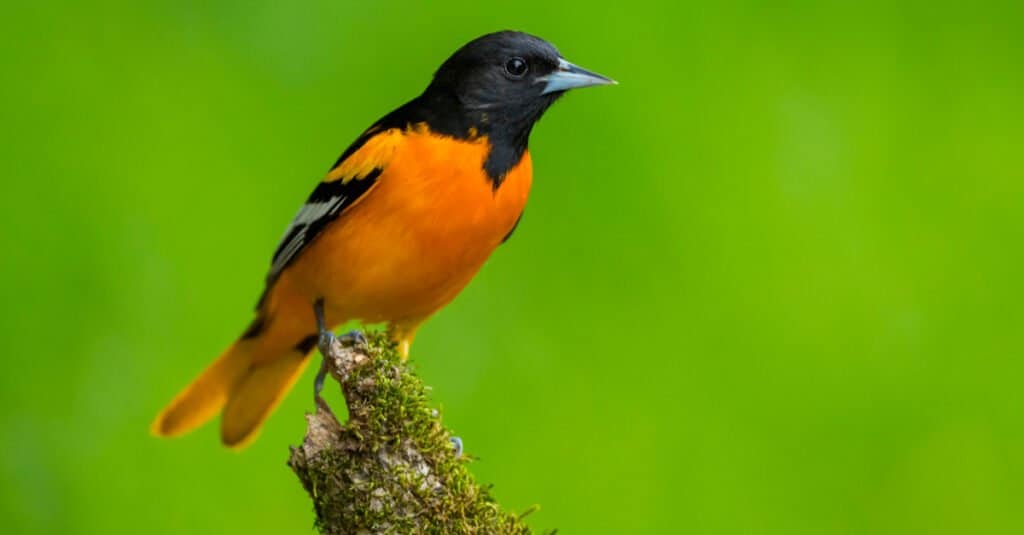
Baltimore orioles are slender and sturdy, with thick necks and pointed bills.
©Agami Photo Agency/Shutterstock.com
Appearance: These birds are slender and sturdy, with thick necks and pointed bills. Males are yellow-orange below and black above with white wing layering.
Location: They breed throughout Michigan and live in open woodlands, forest edges, and along river banks.
Calls: Clear, fluted whistles and staccato chatter.
Backyard Tips: Hang cut-up oranges in trees to attract Baltimore orioles.
Yellow Warbler

The yellow warbler is the most widespread warbler species in the Americas.
©Agami Photo Agency/Shutterstock.com
Appearance: The yellow warbler is a small, perfectly proportioned bird with a uniform egg-yolk yellow color. They also have reddish-brown streaks.
Location: You can find this species in Michigan during spring and summer. Look for them in thickets, wetlands, and along streams.
Calls: Bright, musical “sweet” notes and short chips.
Backyard Tips: You have a good chance of attracting these birds if you have a large yard near a stream.
Types of Large Birds in Michigan
Most birds on this list consist of common small passerines. But what about the large birds in Michigan? Discover where to find these distinctive species.
Great Blue Heron
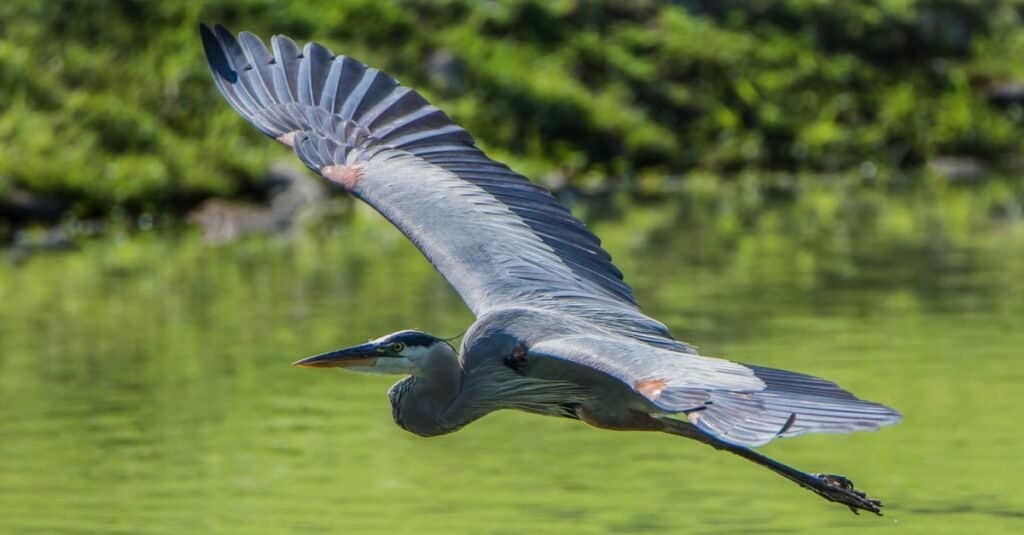
The
great blue heronis the largest North American heron.
©Tom Franks/Shutterstock.com
Appearance: It is the largest North American heron, with long legs, curved necks, and large, pointed bills. They reach up to four feet long and possess a six-foot wingspan. They have bluish-gray plumage and a broad black streak over their eye.
Location: This species lives year-round in Michigan. Look for them across the state in freshwater habitats.
Calls: Harsh squawks and bill snaps.
Backyard Tips: These birds don’t typically come to backyards but may be unwanted visitors to ponds.
Sandhill Crane
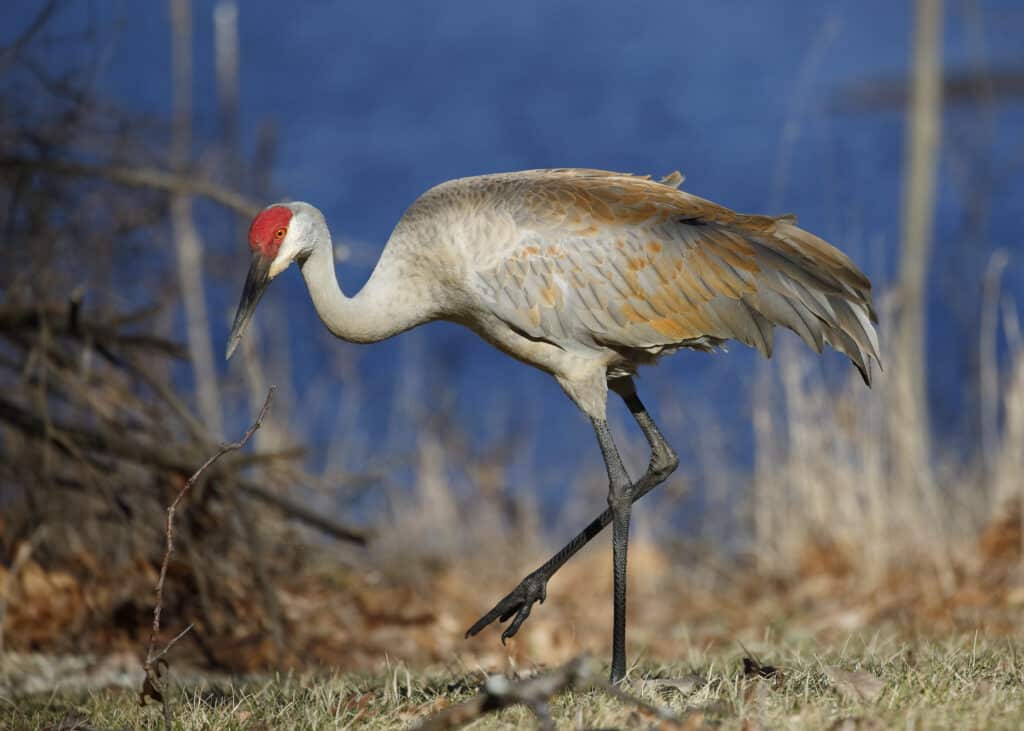
Sandhill cranes are slate gray with red skin on the forehead.
©Brian Lasenby/Shutterstock.com
Appearance: Extremely large with long appendages. They are slate gray with red skin on the forehead.
Location: They breed throughout Michigan. And you can find them in marshes, bogs, and wet meadows.
Calls: Loud, rattling calls
Backyard Tips: These birds do not visit backyards.
Great Egret
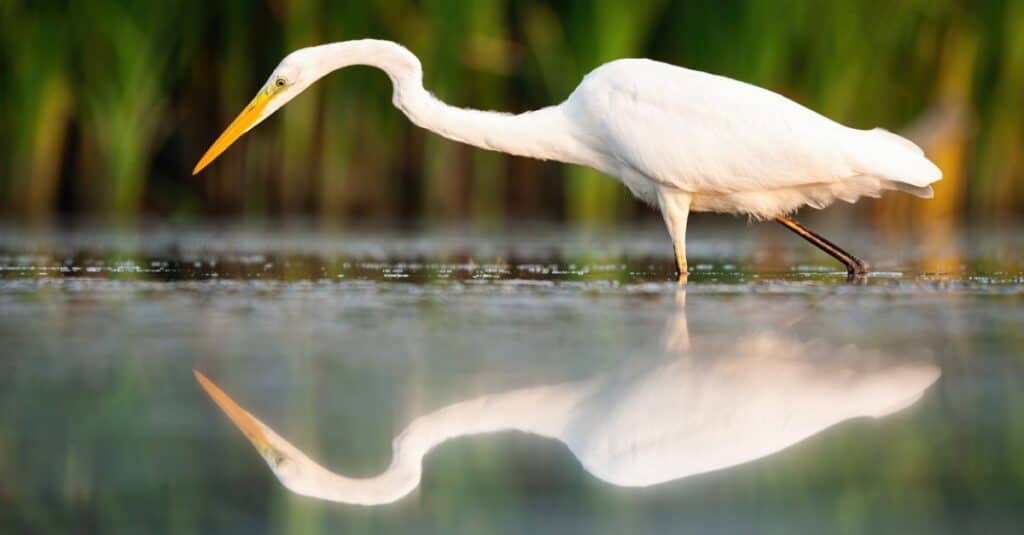
Great egrets have S-curved necks and snow-white plumage with yellow bills.
©WildMedia/Shutterstock.com
Appearance: These tall, wading birds have S-curved necks and snow-white plumage with yellow bills.
Location: They migrate through Michigan’s southern half, stopping in lakes, ponds, and rivers as they travel.
Calls: Gutteral croaks and loud squawks.
Backyard Tips: Wading birds do not typically visit backyards unless your property backs up to an aquatic habitat.
Red-Tailed Hawk
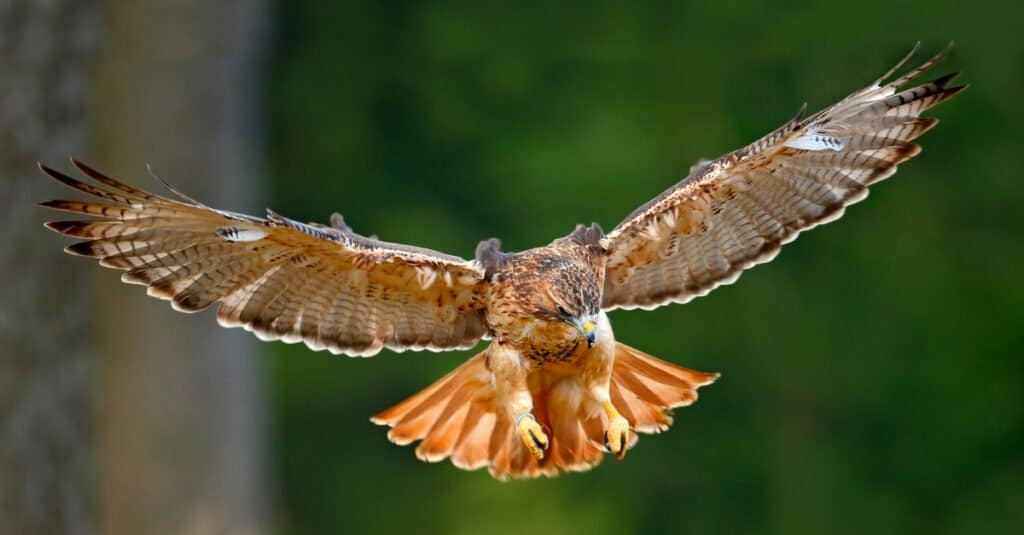
The red-tailed hawk’s distinct tail feathers are a result of the molting process.
©Ondrej Prosicky/Shutterstock.com
Appearance: Large hawks with broad, rounded wings. Most are rich brown above and pale below, with cinnamon-colored tails.
Location: They breed in northern Michigan and have year-round habitats in southern portions of the state. Look for them in grasslands, scrublands, roadsides, fields, and parks.
Calls: High-pitched, hoarse screams
Backyard Tips: You are unlikely to spot these hawks in your backyard unless you have a large property.
Types of Water Birds in Michigan
Michigan is no stranger to water. Check out these common water birds in the state.
Mallard
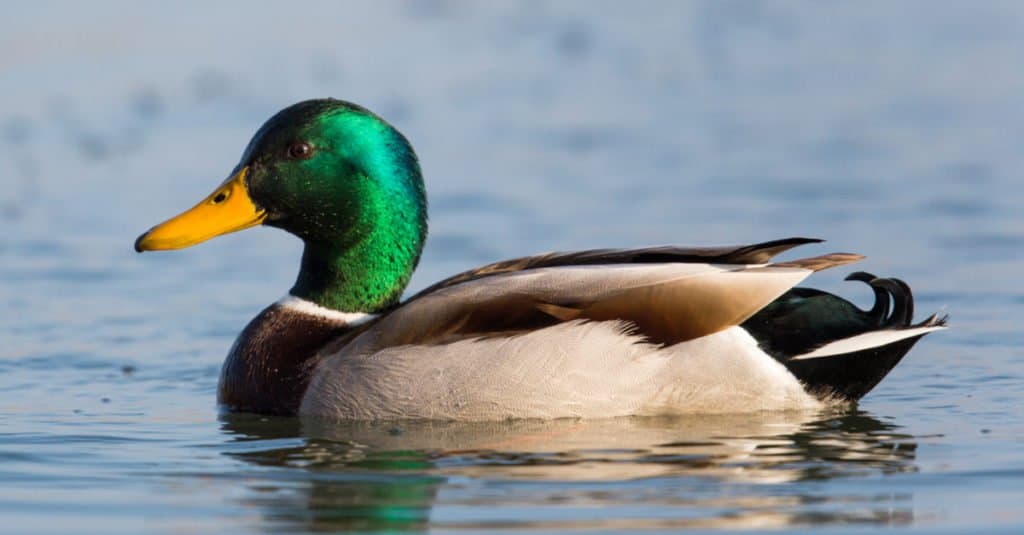
Mallards have wide, flat yellow bills and iridescent green heads.
©Pascal Halder/Shutterstock.com
Appearance: These large ducks have wide, flat yellow bills and iridescent green heads. Their bodies are gray, brown, and black, with blue wing patches.
Location: They breed in northern Michigan, inhabiting any wetland habitat.
Calls: Quacks and rattles
Backyard Tips: You may see these ducks if you have a pond or marshy area.
Northern Pintail
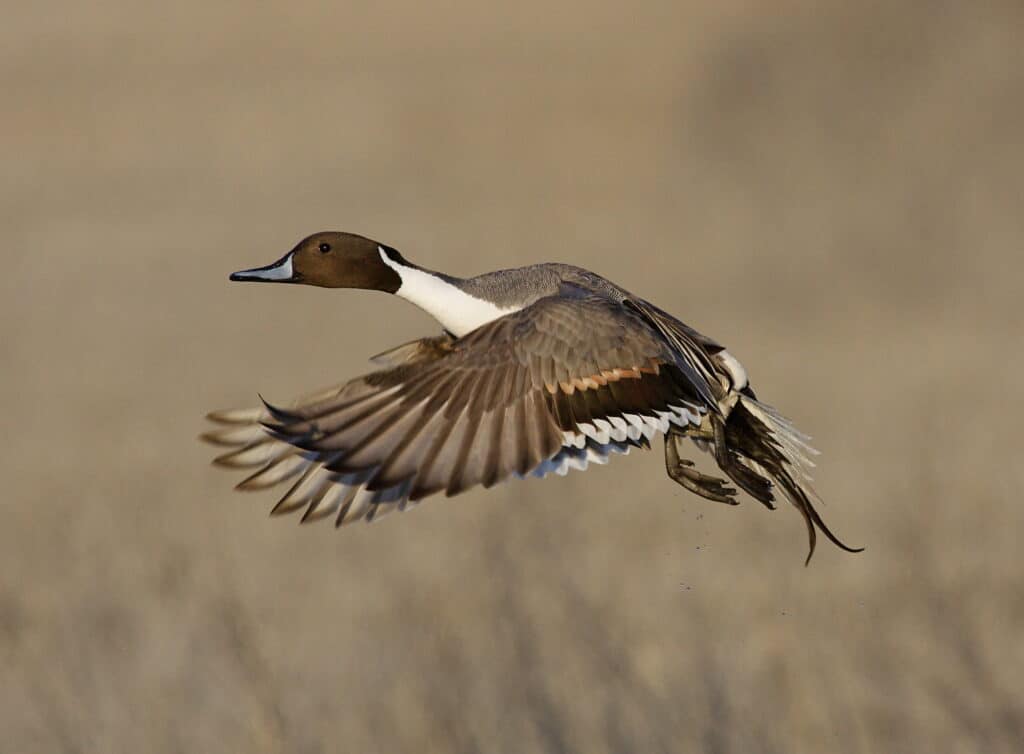
Northern pintails migrate through Michigan and feature small breeding populations.
©Tom Reichner/Shutterstock.com
Appearance: Slender, long-necked ducks. They have chocolate brown bodies and heads with white breasts and lines down their heads and necks. When flying, you can see green inner wing feathers.
Location: Northern pintails migrate through Michigan and feature small breeding populations. They can be found in most wetland habitats.
Calls: Short wheezy whistles and stuttering quacks
Backyard Tips: Similar to mallards, you may find them near ponds.
Wood Duck
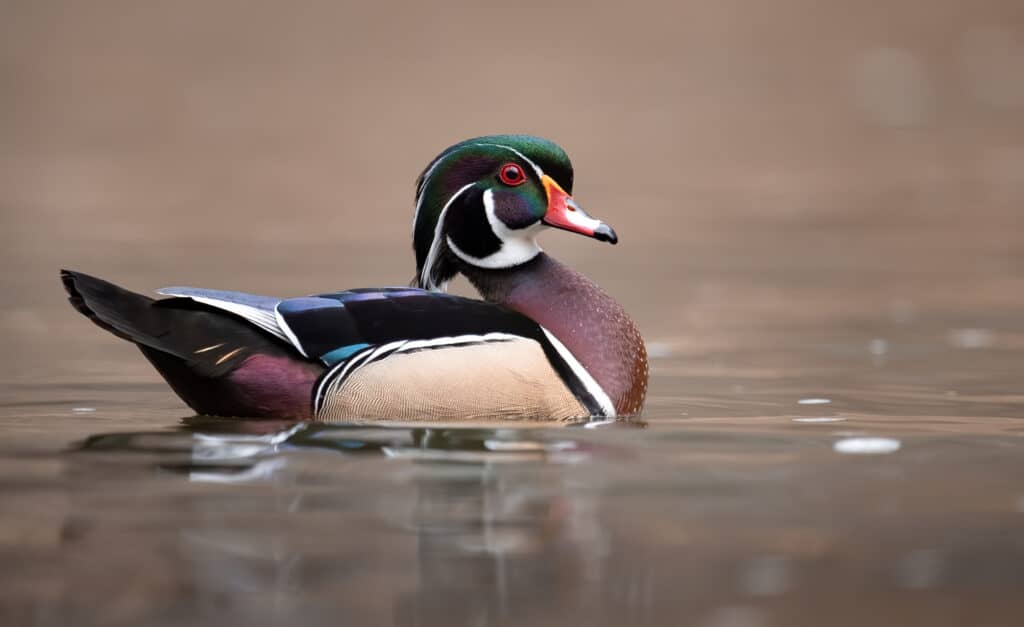
Wood ducks feature boxy, crested heads and long tails.
©Harry Collins Photography/Shutterstock.com
Appearance: They feature boxy, crested heads and long tails. Males have glossy multicolored heads in green, purple, yellow, and red. They also have chestnut breasts and buffy underparts.
Location: They breed in northern Michigan and live year-round in southern Michigan. You can find them in swamps, marshes, and beaver ponds.
Calls: Thin, “zeeting” whistles
Backyard Tips: These birds may use a nesting box, especially if your property lies near water.
Canada Goose

Canada geese have black heads, white cheeks, black necks, tan breasts, and brown backs.
©Krasula/Shutterstock.com
Appearance: These large waterbirds have black heads, white cheeks, black necks, tan breasts, and brown backs.
Location: Breeding populations reside in northern Michigan, and year-round birds reside in southern Michigan. You can find them in many water habitats near grassy areas.
Calls: Loud honks and barks
Backyard Tips: They will visit large, maintained yards near the water’s edge.
Up Next:
The photo featured at the top of this post is © iStock.com/Mason Maron
Sources
- IUCN Redlist, Available here: https://www.iucnredlist.org/
- The Cornell Lab of Ornithology, Available here: https://www.birds.cornell.edu/home/
Thank you for reading! Have some feedback for us? Contact the AZ Animals editorial team.






